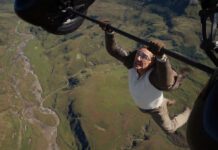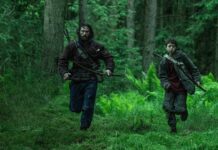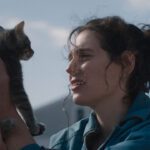
By: IAN SPELLING
“Since the end of `The Lord of the Rings,’ Gollum has never really, really left me,” says Andy Serkis, who played the bug-eyed, distrustful and ring-obsessed Gollum in Peter Jackson’s 2001-2003 trilogy. “Every day, in some way, shape or form, I’m confronted by him.”
It was only natural, then, that Serkis return for an encore engagement in “The Hobbit: An Unexpected Journey.” The first installment in the “Hobbit” trilogy, due for nationwide release on Dec. 14, reunites Serkis with Jackson, who directed him in “The Lord of the Rings” and also in “King Kong” (2005), and who produced “The Adventures of Tintin” (2011), for which Serkis voiced two characters. Jackson utilized motion-capture technology to record Serkis’ performances in those films. The process is now referred to as performance-capture technology, and it also was used to render Serkis’ remarkable portrayal of Caesar in “Rise of the Planet of the Apes” (2011), which many thought should have been Oscar-nominated.
“I’d been gearing up to do `The Hobbit’ for some time,” Serkis says, speaking by telephone from his London home. “There were a lot of delays. Once it was actually green for go, it was very funny and exciting, because the first scene we shot back in New Zealand was a scene with Gollum and Bilbo, with me and Martin Freeman. Martin was just discovering Bilbo. I think Pete chose that scene because, for a start, he wanted a chamber-piece scene that everyone could lock into, that the crew _ and it was practically all the same crew from `Rings’ _ could settle back into, that I could settle back into, with the performance-capture technology.
“It was probably very good for Martin, I think, to do this kind of scene,” he continues, “rather than having to do one with the enormous ensemble cast of dwarves and a wizard. It was the two of us, and so he just had me to focus on.
“Martin and I knew each other,” Serkis adds. “We’re both from the same part of London. We’d circled each other for years. So it was a great place to start, this 12- or 13-minute scene that, as I say, was like a chamber piece.
“Over the course of two weeks we shot it time and time again, in its entirety, from beginning to end pretty much,” Serkis recalls. “Pete just let it go and we played and explored. Martin and I bounced off each other and tried lots of different things.”
As well as he knew Gollum, and as well as he remembered what he had done in the past, Serkis nevertheless hit a roadblock. That roadblock, the easygoing actor says, was Gollum’s voice. What once was precious, pardon the pun, was now all too familiar.
“Having seen and heard so many impersonations people had done of Gollum, having had so many people ask me to do voices for them, having heard it done on `Saturday Night Live’ and seen so many manner of spoofs … I genuinely felt like I was doing an impersonation of myself,” Serkis says. “It took awhile to get over that. I got over it once I plugged into Gollum’s emotional center for the scene that was required.”
When audiences first met Gollum in “The Fellowship of the Ring” (2001), he already was a decrepit, craven figure. In “The Return of the King” (2003), a flashback sequence depicted how Smeagol (Serkis), a hobbit who lived by the Gladden River, became corrupted by the One Ring and fled society, eventually going utterly mad. In “An Unexpected Journey” he lurks in the Misty Mountains, where he has gone to dodge the elements and to be alone in the dark with the One Ring, which obsesses him.
“He’s been there for half the millennium, and not communicated with anything other than the fish he’s tried to kill or the goblins he’s tried to eat,” Serkis says. “So we meet him for this scene in which Bilbo turns up, and the scene revolves around the loss of the ring, the loss of the most important thing to him, the only thing he cares for, really.
“The other significant thing is that we see Bilbo spare Gollum’s life,” Serkis continues. “That’s a seminal moment. Bilbo, in his attempt to escape, could’ve killed him. He lets Gollum live and, by doing so, ensures the destruction of the One Ring. Had he not done that, the power of the ring would have continued.
“It’s really a great scene,” the actor says. “The whole thing ostensibly takes place around these riddles, this battle of riddles between Gollum and Bilbo. They’ve made this pact that, if Gollum wins, he eats Bilbo, and if Gollum loses, he leads Bilbo out of the cave, which he would stick to because there’s a strict code about riddling.”
How much moviegoers will see of Gollum in the next two “Hobbit” adventures, “The Desolation of Smaug” and “There and Back Again,” remains to be determined. However, in any case Serkis will make his presence felt in the subsequent chapters: In addition to playing Gollum, he served as the production’s second-unit director and, as such, was on hand for the entire shoot and filmed in 3D and at 48 frames per second.
“It was all an enormous shock,” Serkis says, laughing. “Pete has a habit of offering me these incredible opportunities at short notice. Four weeks before principal photography was to start, as I was getting ready to play Gollum, I got an email from Pete and (co-producer Fran Walsh) saying, `We’d like you to direct the second unit.’
“Pete has known for many years that I’ve been leaning toward directing, and he thought, in his wise way, that this would be a great opportunity for me,” says Serkis, who now owns his own performance-capture company and is set to direct a film version of George Orwell’s “Animal Farm.” “Pete told me to make some bold choices. He knew that I’d been through the Middle-earth experience, that I shared his sensibility and taste, and understood exactly where he was coming from.
“Also, because the movie was so large and the cast was so large, second unit shared a lot of the responsibility,” Serkis concludes. “It wasn’t little pickups here and there. We shot for 200 days, with main unit and second unit sharing cast. We shot battle sequences, aerials, drama and the whole kit and caboodle.
“It was a big, big operation _ and a tremendous learning experience.”
Ian Spelling is a New York-based freelance writer.
c.2012 Ian Spelling
Distributed by: The New York Times Syndicate
he/him • aapi • intj • geek • photographer • journalist • podcaster • martial artist • foodie • dj • cinephile • gamer • traveler




























